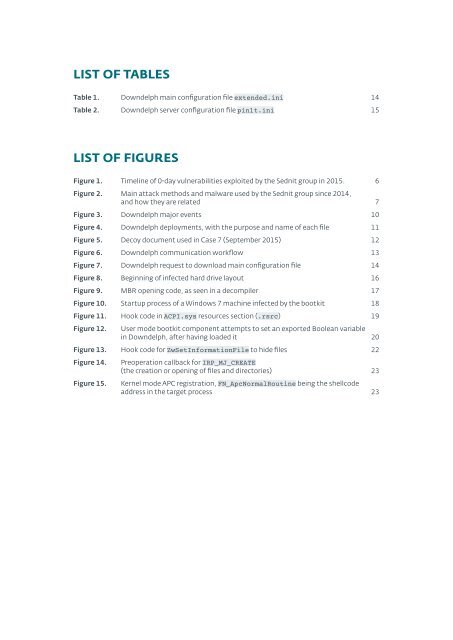En Route with
eset-sednit-part-3
eset-sednit-part-3
You also want an ePaper? Increase the reach of your titles
YUMPU automatically turns print PDFs into web optimized ePapers that Google loves.
List of Tables<br />
Table 1. Downdelph main configuration file extended.ini 14<br />
Table 2. Downdelph server configuration file pinlt.ini 15<br />
List of Figures<br />
Figure 1. Timeline of 0-day vulnerabilities exploited by the Sednit group in 2015. 6<br />
Figure 2. Main attack methods and malware used by the Sednit group since 2014,<br />
and how they are related 7<br />
Figure 3. Downdelph major events 10<br />
Figure 4. Downdelph deployments, <strong>with</strong> the purpose and name of each file 11<br />
Figure 5. Decoy document used in Case 7 (September 2015) 12<br />
Figure 6. Downdelph communication workflow 13<br />
Figure 7. Downdelph request to download main configuration file 14<br />
Figure 8. Beginning of infected hard drive layout 16<br />
Figure 9. MBR opening code, as seen in a decompiler 17<br />
Figure 10. Startup process of a Windows 7 machine infected by the bootkit 18<br />
Figure 11. Hook code in ACPI.sys resources section (.rsrc) 19<br />
Figure 12.<br />
User mode bootkit component attempts to set an exported Boolean variable<br />
in Downdelph, after having loaded it 20<br />
Figure 13. Hook code for ZwSetInformationFile to hide files 22<br />
Figure 14.<br />
Figure 15.<br />
Preoperation callback for IRP_MJ_CREATE<br />
(the creation or opening of files and directories) 23<br />
Kernel mode APC registration, FN_ApcNormalRoutine being the shellcode<br />
address in the target process 23


